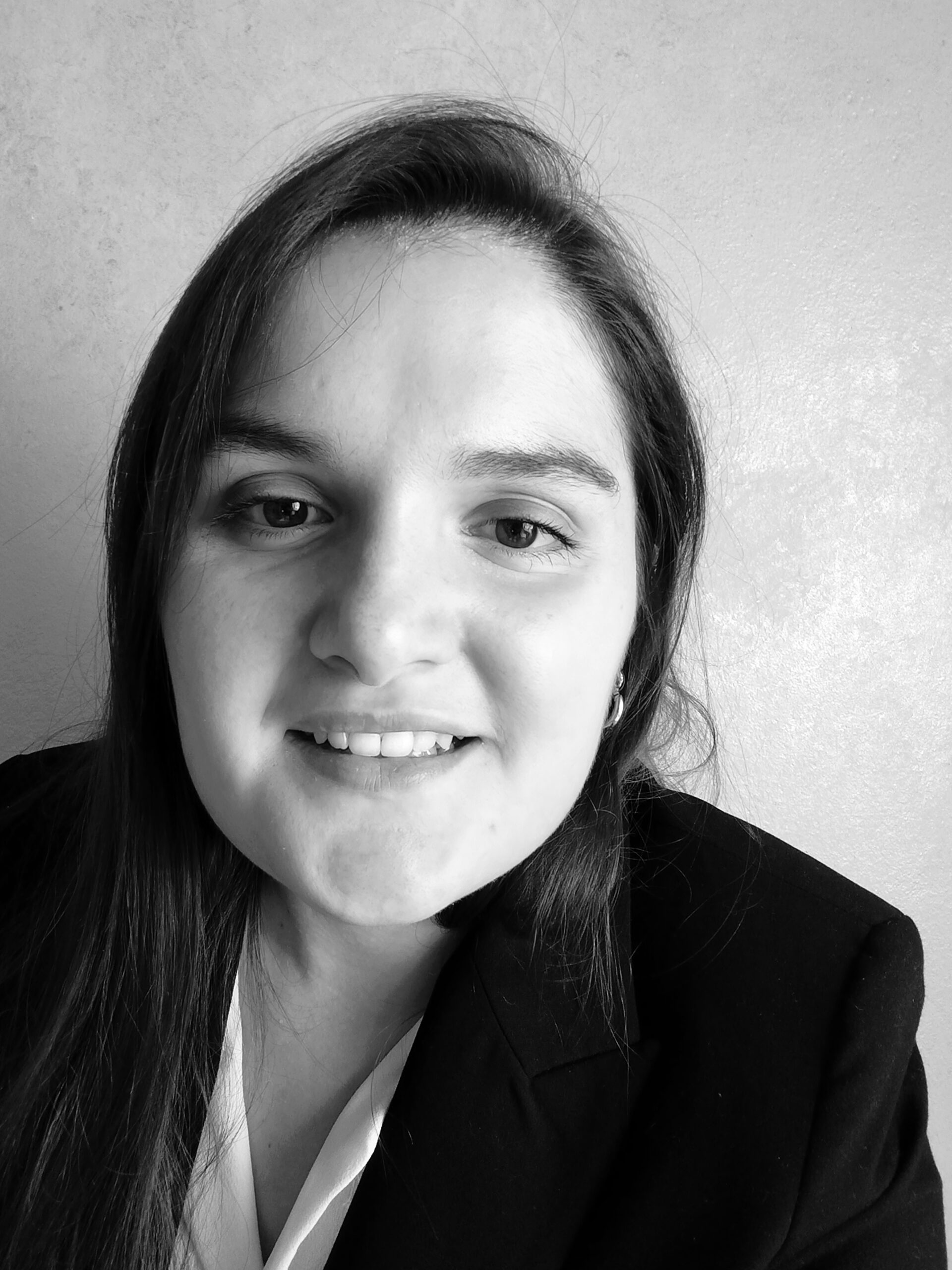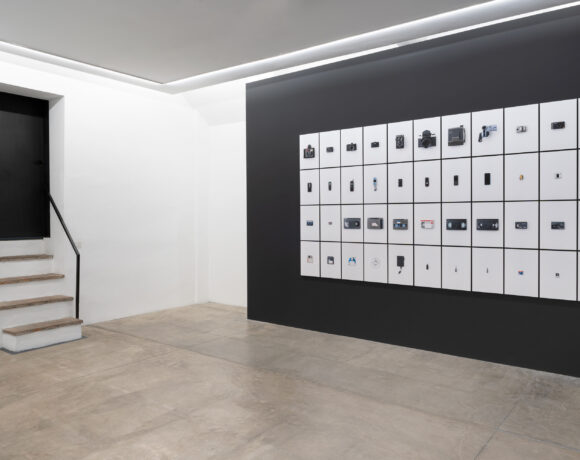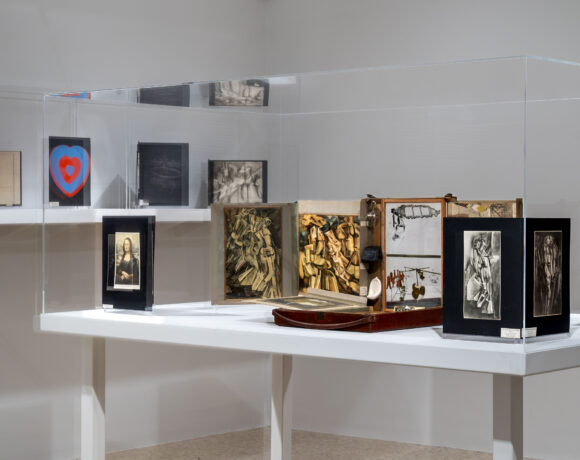Daniela Comani is a visual artist born in 1979. She collaborates with the Studio G7 Gallery in Bologna and has several projects concerning language and media to her credit. One of her most famous projects, started in 2013, is part of the series Are You Mine, and reflects on the media language for representing gender-based violence.

Daniela Comani, “Perturbazione”, 2023, sequence of 12 text-images, archival pigment print on Photo Rag, each. 42 x 29.7 cm, and site-specific photo-installation on the floor, 130 m2, Fondazione La Rocca, Pescara, 19 November 2023 – 2 March 2024. Photo Paolo Dell’Elce, courtesy the Artist and Studio G7, Bologna
Giulia Elisa Bianchi: What are you currently working on?
Daniela Comani: The projects I have been working on in the last twelve months are all related to language. For example, I finished working on ‘Perturbation’, a sequence of image-texts about the climate crisis. These are weather forecasts that I have collected over time, and they are also thought of as a great metaphor for the current social and political situation. The work consists of an artist’s book and a site-specific installation that was set up at the Fondazione La Rocca in Pescara, on the occasion of the solo exhibition curated by Francesca Guerisoli and held from 18 November 2023 to 10 February 2024. As always, I work on several projects. I am thinking of ‘Good Morning Ladies and Gentlemen’, a multi-channel and multilingual video-installation that in a single day will collect two decades of terrorist attacks (from New York to London, from Madrid to Paris, from Brussels to Nice, from Grozny to St. Petersburg, from Dacca to Bali, from Nairobi to Israel) that really happened but that are re-enacted here in another chronological order. Or ‘Coverversionen’, a work in progress that has been going on since 2007 where I myself become the subject of Der Spiegel or Time Magazine’s cover headlines, in a sort of media diary, which I will produce as an artist book in the form of a mock magazine and photographic series. Here, besides language, we find another central theme of my artistic research: gender issues.

Daniela Comani, 2 photos from the “Coverversionen / Cover Versions” series (work in progress since 2007), pigment prints, each. 40 x 30 cm. Ph courtesy the Artist and Studio G7, Bologna
How did your interest in language begin?
In 1993, while still a student in Berlin, I created a project entitled ‘Kommunikation versus Entfremdung’ (Communication versus Estrangement): a video installation with four monitors and a player showing four people from four different nationalities intent on reading texts in a foreign language they do not understand. An American reads Hugo’s ‘Les Miserables’ in French, a Frenchman reads Goethe’s ‘Faust’ in German, a German reads Dante’s ‘Divine Comedy’ in Italian, and a Spaniard reads Kierkegaard’s ‘Aut-Aut’ in Danish. Looking at this first video work of mine today, I find several elements that have characterised my work: I am thinking of the alienating aspect, the interest in language, text, extracts from pages of classic novels.

Daniela Comani, 36 video stills from “Archive in Progress”, 2015/2020, video loop, 40 min. Ph courtesy the Artist and Studio G7, Bologna
Would you tell me about the ‘You Are Mine’ project?
‘You Are Mine’ (2022) consists of a series of works/texts-images simulating newspaper clippings of feminicide cases that I collected, filed, selected and finally manipulated. These are acts of domestic and gender-based violence that actually happened and that I rewrote by inverting the feminine with the masculine, in this way the victim becomes the perpetrator and vice versa. This crime story, once turned upside down, presents scenarios of relationships that are almost impossible due to age differences, as well as social roles and professions exercised. .
Was it difficult to relate to such a sensitive topic?
It was an urgency that began in 2013 after a media wave about cases of domestic and gender-based violence. It is no coincidence that it was in 2013 that the annual increase in the cases of feminicide in Italy led to Decree No. 93 converted shortly afterwards into Law No. 119, known as the Femicide Law.

Daniela Comani, “Sono stata io. Diario 1900-1999”, 2002/2006, print on net vinyl, 300 x 600 cm, detail. Ph courtesy the Artist and Studio G7 Gallery, Bologna
How do you design the visual part of the works compared to the writing? For example, what criteria do you use to choose fonts and paper format?
The choice of fonts is never random, since we are dealing with image-text, it becomes part of the works themselves: form and content must coincide. In the 3 x 6 metre print ‘It was me. Diary 1900-1999′ the typewriter font belongs to the 20th century, which immediately refers to the still analogue protocols and archives. The choice of the large format was determined by trying to achieve almost a scenography: I wanted the visitors to face a wall larger than themselves, to feel the weight of the story, the weight that I myself felt while thinking and writing the diary.
The manipulation of language is a recurring theme of yours; what role do you think it plays in contemporary art today?
If in mass media and social media it means disinformation and is disturbing, in art the manipulation/transformation of language is redeemed by giving shape to often very intriguing works. It is an opportunity to reflect and make people think, even critically, about the reality of media information.

Daniela Comani, “You Are Mine”, 2002, prints on cotton and aluminium, each. 110 x 70 cm. National Gallery of Modern and Contemporary Art, Rome, 17 October 2022 – 26 February 2023. Ph courtesy the Artist and Studio G7, Bologna
What are your cultural references?
The source of my work has been not only the media world of information (print and online newspapers), but also the literary and film world. When I was working on ‘It was me. Diary 1900-1999′ as my travelling companions, on my desk, I had Marguerite Yourcenar’s “Memoirs of Hadrian”, Virginia Woolf’s “Orlando”, Luther Blisset’s “Q” and Sarah Kane’s theatre pieces.
In your works there is a strong interest in the history of the last century.
First of all it is my century: I was born in 1965. At the beginning of 1999 I felt a great heaviness in relation to past historical events, a century was ending and also a millennium. I had to digest what I was experiencing, and also a bit for this reason I started working on ‘It was me. Diary 1900-1999’. Thus, in the process of selecting and recontextualising the material collected and archived in the previous years, I performed this great act of appropriation of words and images. I still consider the 20th century to be the most intense in all of history, not only because it is my century, but also because of the intensity of contradictions that characterise it, between wars and crimes, inventions and progress. For example, the women’s emancipation movement from the suffragettes to the present day; the discovery of penicillin, antibiotics, organ transplants; industrialisation and the assembly line; the invention of radio, television, the Internet and so on.

Daniela Comani, “It Was Me. Around Alexanderplatz in 32 Days. 1805-2007”, 2007, 32 billboards, each 187 x 377 cm, Alexanderplatz Metro, Berlin, 25. Oktober 2007 – 29. Februar 2008. Photo Thomas Bruns, courtesy the Artist and Studio G7, Bologna
Can language be defined as a body-text, to quote the feminist writer Gloria Anzaldua?
There is a deep connection between writing, language, identity and culture. With all the complexities that these relationships entail, language is linked to identity. One could say that language is not only a communication tool, but also the bodily expression of who we are. A new project I am preparing, ‘Years Months Days Hours’, is a sound installation composed of a quartet of voices, an audioloop. In this work, the relationship between text, language and voice flows into identity: it is in fact a self-portrait. And so it is about the body.
Info:
https://www.danielacomani.net/

Giulia Elisa Bianchi (Varese, 1998) is an emerging curator and author. After the First Level academic diploma in Disciplines for the Valorization of Cultural Heritage at the Brera Academy of Fine Arts in Milan, she decided to follow her interest in contemporary art at the two-year specialist course in Visual Arts and Curatorial Studies at New Naba Academy of Fine Arts. She considers curating “a writing of spaces and a way of valorising the expressive needs of the artist”.






NO COMMENT